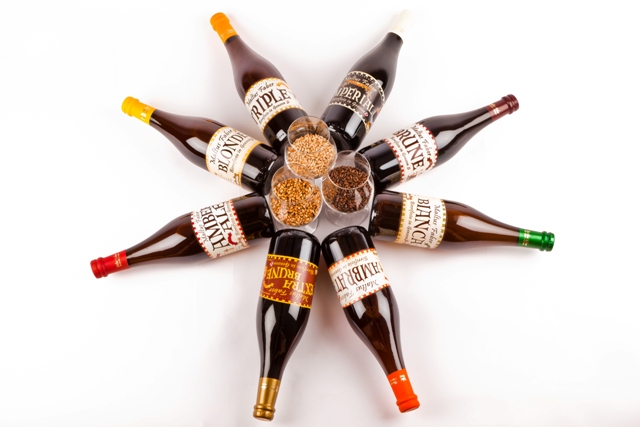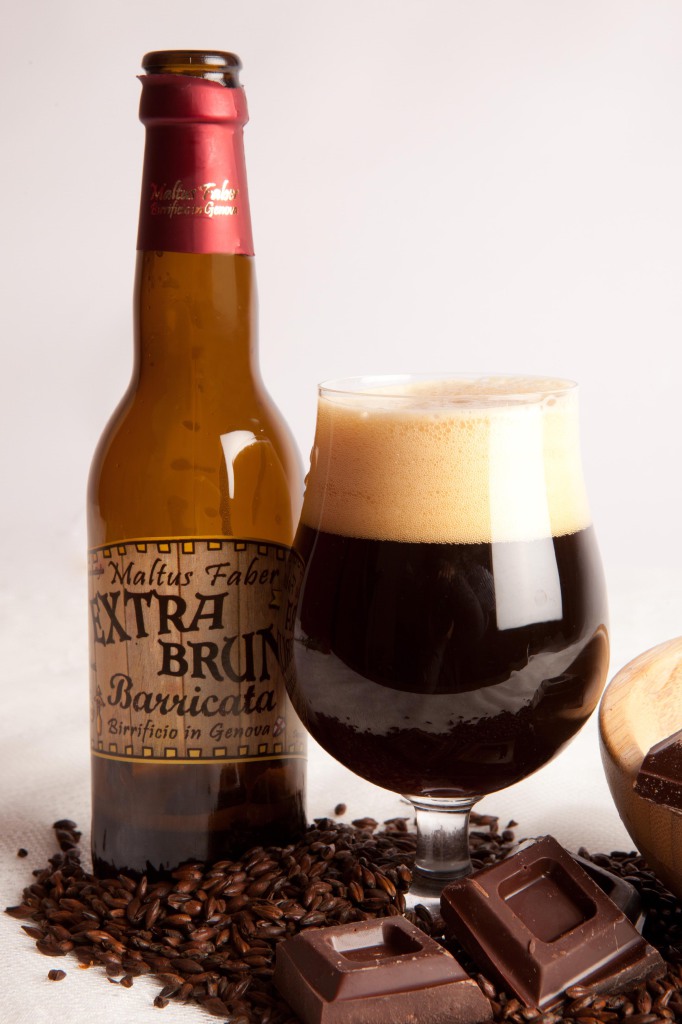 There are craft beers which have nothing to envy to a great wine, with regard to aromatic complexity, body, and longevity. So, they can be tasted, though not pasteurized, after years of aging in bottle, thanks to the special yeast used for producing them. A clear example of these characteristics is the Imperial 'Russian Stout' produced by Maltus Faber, the brewery of Rivarolo, a district of Genoa which developed in Polcevera, in the western area of the city. Here at the beginning of industrialization many of the top companies in the Ligurian capital found a place. Of them often only ruins remained. And just Maltus Faber, or rather its creators, Massimo Versaci and Fausto Marenco, started the architectural renovation of part of one of those factories, Cervisia, the historic beer of Genoa which entered a large industrial group at the end of twentieth century. This group preferred to gradually marginalize it from the distribution system, until at first it became a discount product, and then was forced to disappear.
There are craft beers which have nothing to envy to a great wine, with regard to aromatic complexity, body, and longevity. So, they can be tasted, though not pasteurized, after years of aging in bottle, thanks to the special yeast used for producing them. A clear example of these characteristics is the Imperial 'Russian Stout' produced by Maltus Faber, the brewery of Rivarolo, a district of Genoa which developed in Polcevera, in the western area of the city. Here at the beginning of industrialization many of the top companies in the Ligurian capital found a place. Of them often only ruins remained. And just Maltus Faber, or rather its creators, Massimo Versaci and Fausto Marenco, started the architectural renovation of part of one of those factories, Cervisia, the historic beer of Genoa which entered a large industrial group at the end of twentieth century. This group preferred to gradually marginalize it from the distribution system, until at first it became a discount product, and then was forced to disappear.
The labels of Maltus Faber, active since 2008, have nothing to do with the time of end of life for Cervisia. The only element of similarity perhaps consists in resuming, at a distance of about a century, the spirit of the many breweries which had flourished in the early twentieth century in all Italian cities, with a limited commercial presence in the territory, because the transport and distribution network was still underdeveloped. Versaci recalls: «For a long time, Italian historic breweries met a local demand, moving their beer, which was not pasteurized, in cooled barrels, as the technology of the time could allow». High quality raw materials
High quality raw materials
![]() Today, however, the supply of premium quality raw materials, and especially the technological refinement, allow a producer as Maltus Faber, who is inspired by the beers of Northern Europe and in particular the Belgian ones, to produce even without subjecting the beer to industrial pasteurization. This process destroys the distinctive elements of the product. However, by using ingredients and yeast which continue to live and re-ferment in the bottle for a long time, it is possible to preserve the organoleptic characteristics of the product for years.
Today, however, the supply of premium quality raw materials, and especially the technological refinement, allow a producer as Maltus Faber, who is inspired by the beers of Northern Europe and in particular the Belgian ones, to produce even without subjecting the beer to industrial pasteurization. This process destroys the distinctive elements of the product. However, by using ingredients and yeast which continue to live and re-ferment in the bottle for a long time, it is possible to preserve the organoleptic characteristics of the product for years.
![]() This happens for the Imperial ‘Russian Stout,’ but for ‘Extra Brune’, too, also proposed in a version that provides, before packaging, an aging for six months in oak barrels which have contained Brunello di Montalcino wine and ‘Bricco dell’Uccellone’, one of the best Barbera wines from Piedmont. In both cases, the soft pleasure of beer is enriched and complemented by notes of wood and wine. They are beers for meditation that can be drunk in unusual combinations with oysters and shellfishes, according to Irish traditions, but also with seasoned marbled cheese or such desserts as the ‘Panettone’ of Genoa, dry pastries, nougat, or Gianduia (Piedmontese soft nut chocolate) with hazelnuts.
This happens for the Imperial ‘Russian Stout,’ but for ‘Extra Brune’, too, also proposed in a version that provides, before packaging, an aging for six months in oak barrels which have contained Brunello di Montalcino wine and ‘Bricco dell’Uccellone’, one of the best Barbera wines from Piedmont. In both cases, the soft pleasure of beer is enriched and complemented by notes of wood and wine. They are beers for meditation that can be drunk in unusual combinations with oysters and shellfishes, according to Irish traditions, but also with seasoned marbled cheese or such desserts as the ‘Panettone’ of Genoa, dry pastries, nougat, or Gianduia (Piedmontese soft nut chocolate) with hazelnuts. Target: United States
Target: United States
The ‘Imperial’ beer is a ‘stout’ one (always highly fermented, as all ‘Maltus Faber’ beers) which resumes the one that in the late '700 was produced in England in order to be shipped by sea to Catherine the Great’s Court, in St. Petersburg. In order to bear the long roll of the ship during the journey, the beer had to be properly processed, also increasing its alcohol content, which exceeded 10%. Today, the Imperial ‘Russian Stout’ is included by many experts in the family of barley -wines.
The characteristics which distinguish these two labels, as well as many other ones proposed by Maltus Faber, allow exporting them not only at a relatively short distance, as to the Principality of Monaco, not far away from the nearby border of Ventimiglia, but also to Japan, thanks to the contacts which the two partners have established with importers from Far East. Versaci closes: «Now we are considering the opportunity of establishing a presence in the United States, where our products have already been appreciated. A possible obstacle to overcome can consist in the production capacity of the system we have at present at our disposal, which is now calibrated on 90 thousand litres per year. Before starting the distribution in the USA, perhaps we should increase it, in order to avoid the risk of disappointing the expectations from a desirable surge in demand». 
White
Alcohol 4.7%
Serving temperature 7-9 ° C
Soft taste, slender body, and pleasantly refreshing. Ideal as an aperitif, it can be combined with fish, white meats, and first courses with light seasonings.
Amber Ale
Alcohol 5.2%
Serving temperature 7-9 ° C
Rich in floral aromas and citrus notes, typical of cold hopping. It is excellent alone and ideal with ‘pasta alla carbonara’ (with bacon, eggs, and sheep’s milk cheese). It goes well with slightly seasoned cheeses and roast beef.
Blonde
Alcohol 5.5%
Serving temperature 8-10 ° C
It is characterized by great drinkability, cool and refreshing, with herbaceous fruity aroma. It is ideal combined with first courses with light seasonings, pesto, baked fish, white meats, vegetable pies.
Ambrata
Alcohol 7 %
Serving temperature 10-12 ° C
Its soft and full taste distinguishes itself for caramel notes. It can be tasted with elaborate first courses, grilled meats, seasoned salami and cold pork meats, and ripe cheeses.
Brune
Alcohol 8 %
Serving temperature 12-14 ° C
Its aroma is fine, slightly toasted, with coffee notes a the end. It is excellent with red meats, marbled cheeses, shellfishes, and chocolate desserts.
Triple
Alcohol 8 %
Serving temperature 10-12 ° C
It has an intense, spicy, and alcoholic aroma. It goes well with salami and cold pork meats, fried fish, game, battered vegetables, pancake, and ripe sheep’s milk cheese.
Extra Brune
Alcohol 10%
Serving temperature 14 ° C
Its aroma is complex, with a scent of alcohol. Its taste is soft and velvety, with dark notes from caramel to chocolate. It is excellent with very ripe Parmigiano cheese, dry pastries, and chocolate.
Imperial
Alcohol 7.8%
Serving temperature 14-16 ° C
It is inspired by the strong ale beers which in the past were produced for warming up Tsars’ cold winters. It is black and sweet. It is suitable for consumers who prefer strong and fine tastes. Its aroma is intense and reminds coffee and chocolate.
Extra Brune Barricata
Alcohol 10 %
Serving temperature 14 ° C
It is the Extra Brune aged in oak barrels. The soft pleasantness of the base beer is enriched and complemented by notes of wood and wine.
Imperial Barricata
Alcohol 7.8%
Serving temperature 14-16 ° C
It is the Imperial aged in oak barrels. The beer, already rich and complex, thus acquires a wine shade which completes its character.
Blonde Hop
Alcohol 5.5%
Serving temperature 7-9 ° C
It has the same basic features as ‘Blonde’ with a generous addition of hops that gives an intense grassy and citrusy aroma. It can be tested as an aperitif.
Triple Hop
Alcohol 8 %
Serving temperature 9-11 ° C
Cold hopping generates an explosive flavour, with an especially dry and fresh taste. The suggested combinations are the same as for Triple, but it is excellent alone, too.
Birra di Natale (Christmas Beer)
Alcohol 8 %
Serving temperature 9-11 ° C
It is produced without the addition of spices, but its character is almost spicy and alive, thanks to the clever use of malts, hops, and natural fermentation. Its taste is soft, with just a hint of ‘sweet’, balanced by hop. The various shades of caramel, biscuit, and chocolate given by the malts follow each other in never cloying ways, with a pleasantly ‘heating’ end. This beer can accompany any meal and can be worthily proposed in the lavish lunches and dinners in the Christmas period.
